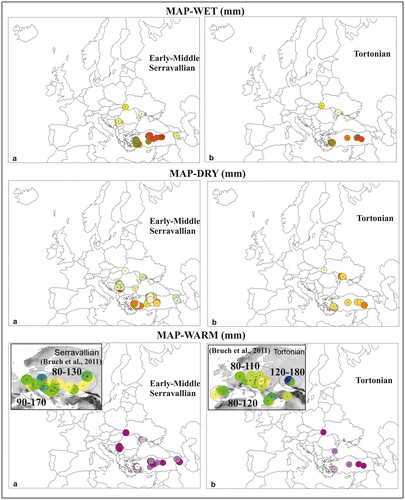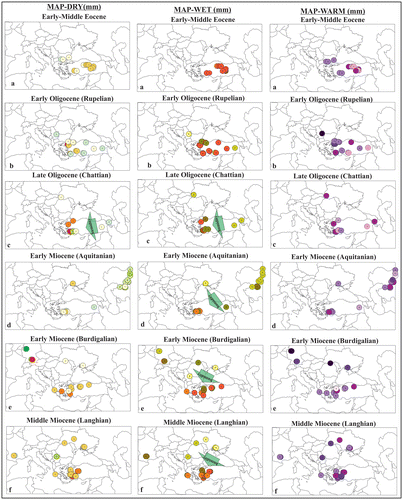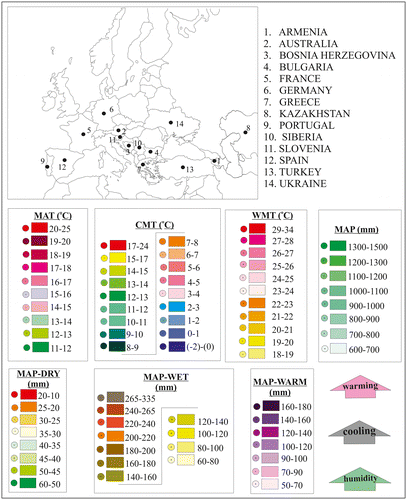Figures & data
Table 1. Coexistence intervals of central Europe and Anatolia for the Eocene.
Figure 1. Climate evolution in the Cenozoic: symbols on the colour bars belong to average coexistence approach values (CMT, MAT, WMT and MAP) of Anatolia and black-white line indicates the climatic trend from the Eocene to late Miocene.
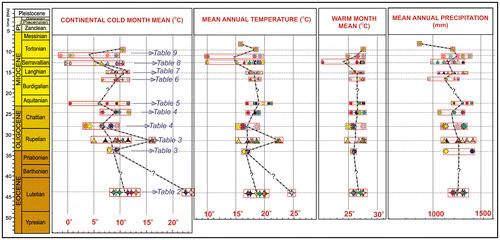
Figure 2. Climate evolution in the Cenozoic: Continental CMT, MAT, WMT and MAP records for North Germany and global oxygen isotope record from Zachos et al. (Citation2001). The original record from Mosbrugger et al. (Citation2005) is shown in grey, calibrated data are in colour (green, blues and purple) (WB: Weisselster Basin; LRB: Lower Rhine Basin in Germany). Red-white line indicates the climatic trend from the Eocene to late Miocene of Anatolia.
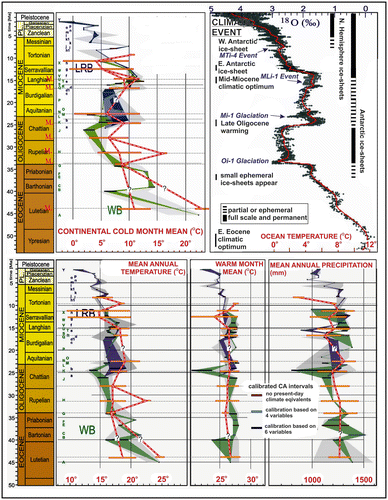
Table 2. Coexistence intervals of central Europe and Anatolia for the early–middle Oligocene.
Figure 3. Mangrove, back mangrove and marine palynomorphs abundance and distribution of Anatolia from the Eocene to Miocene.
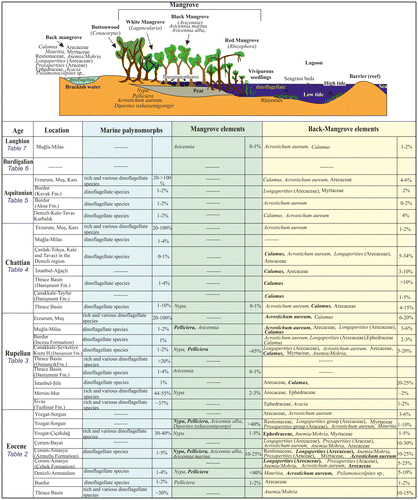
Table 3. Coexistence intervals of central Europe and Anatolia for the late Oligocene.
Table 4. Coexistence intervals of central Europe and Anatolia for the early Miocene (Aquitanian).
Table 5. Coexistence intervals of central Europe and Anatolia for the late early Miocene (Burdigalian).
Table 6. Coexistence intervals of central Europe and Anatolia for the early middle Miocene (Langhian).
Table 7. Coexistence intervals of central Europe and Anatolia for the late middle Miocene (Serravallian).
Table 8. Coexistence intervals of central Europe and Anatolia for the early late Miocene (Tortonian).
Figure 4. (a) Palaeogeographic globes of the Mediterranean and Paratethyan from Eocene, the Middle Miocene (after Popov et al., Citation2004; Rögl, Citation1998; Harzhauser & Piller, Citation2007), (b) Plants distribution in the mangrove palaeocommunity (P: Pelliciera, a: Acrostichum, black circle: Nypa, Ba: Barribtonia, A: Avicennia, R: Rhizophora, S: Sonneratia, Ac: Acanthus, B: Bruguiera, C: Ceriops and E: Excoecaria) (Plaziat, Cavagnetto, Koeniguer, & Baltzer, Citation2001). (“Red “A” for the studied section).
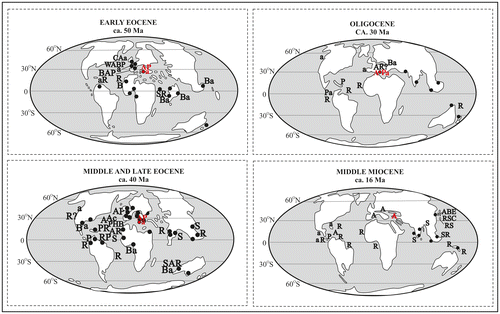
Figure 5. Mean annual temperature in Europe and Anatolia: (a) Eocene, (b) Rupelian, (c) Chattian, (d) Aquitanian, (e) Burdigalian and (f) Langhian and legend of Figure .
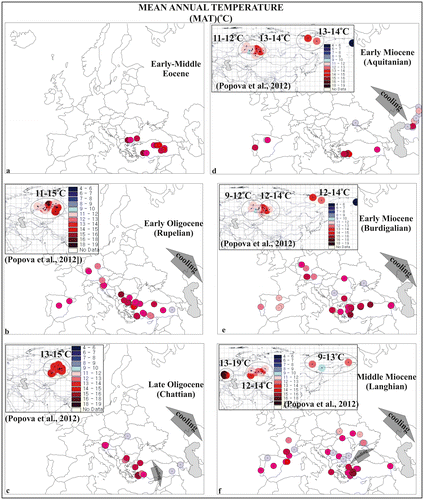
Figure 6. Mean annual coldest month in Europe and Anatolia: (a) Eocene, (b) Rupelian, (c) Chattian, (d) Aquitanian, (e) Burdigalian and (f) Langhian and legend of Figure .
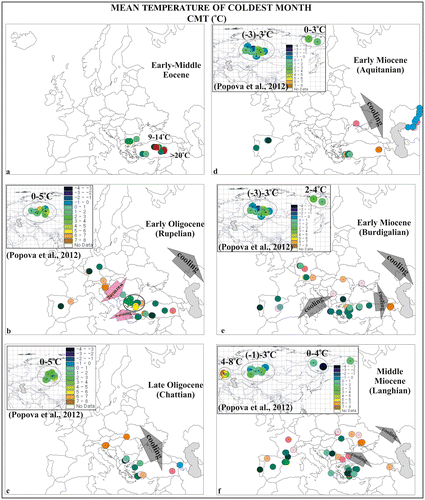
Figure 7. Mean annual warmest month in Europe and Anatolia: (a) Eocene, (b) Rupelian, (c) Chattian, (d) Aquitanian, (e) Burdigalian and (f) Langhian and legend of Figure .
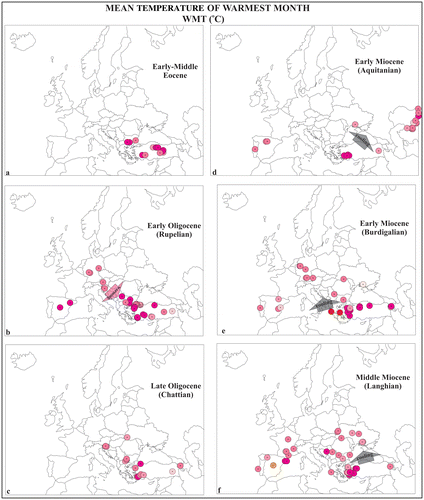
Figure 8. Mean annual precipitation in the Europe and Anatolia: (a) Eocene, (b) Rupelian, (c) Chattian, (d) Aquitanian, (e) Burdigalian and (f) Langhian and legend of Figure .
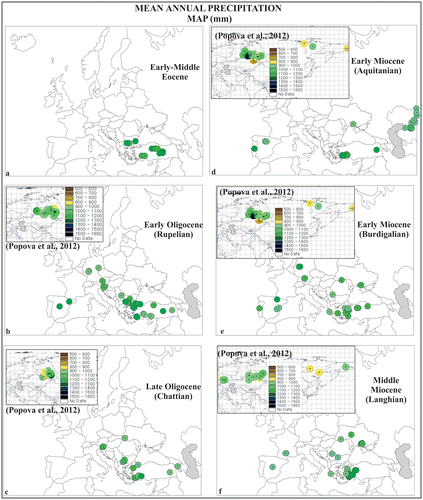
Figure 10. Mean annual temperature, mean annual coldest month, mean annual warmest month and mean annual precipitation in Europe and Anatolia (a) Serravallian and (b) Tortonian (for detail legend see Figure ).

Figure 11. Precipitation of driest, wettest and warmest months in Europe and Anatolia: (a) Serravallian and (b) Tortonian (for detail legend see Figure ).
